Abstract
A study was performed in five normal men in whom left ventricular volume was measured by thermodilution in the supine and 60° head-up postures, in the control state, and then during steady-state response to isoproterenol. The mean rate of circumferential shortening of the left ventricle was calculated for each of the postures in both inotropic states and was found to remain constant in the control state at 12.5 ±0.6 cm/sec in the supine posture and 13.3 ±0.5 cm/sec in the tilted posture. Similarly, mean rate of circumferential shortening remained constant in response to the positive inotropic effect of isoproterenol at 20.9 ±0.5 cm/sec in the supine position and 20.7 ±0.5 cm/sec in the tilted posture. It is concluded that the constancy of mean rate of circumferential shortening over the relatively broad physiologic range of left ventricular end-diastolic volume and mean force of ejection during a given state of myocardial contractility represents the coupled reciprocal influences of ventricular wall tension and myocardial fiber length on the velocity of ventricular wall shortening. Unlike stroke work, stroke power, and mean rate of left ventricular ejection, which are volume-dependent parameters of myocardial performance, the mean rate of circumferential shortening appears to be a reasonable index of left ventricular contractility, which in steady-state conditions is independent of left ventricular end-diastolic volume and mean ventricular wall force of ejection. In this study, changes in mean rate of circumferential shortening associated with changes of heart rate were small and variable.
Full text
PDF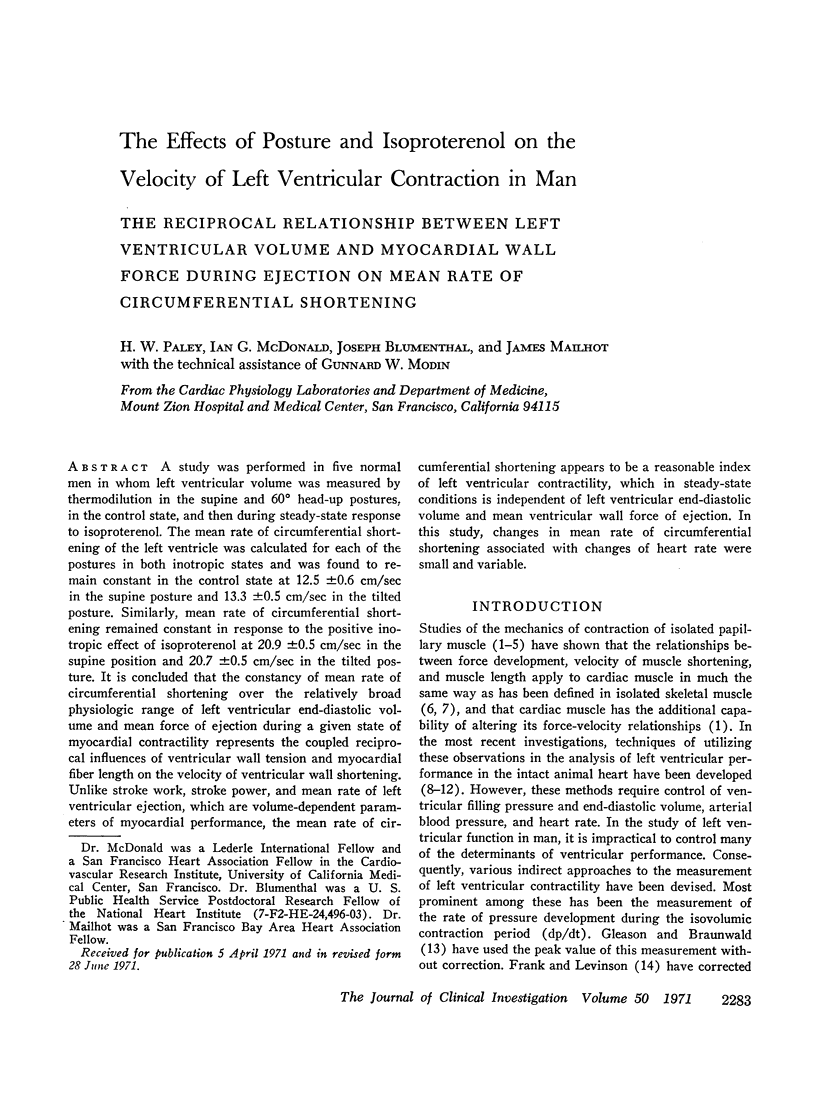
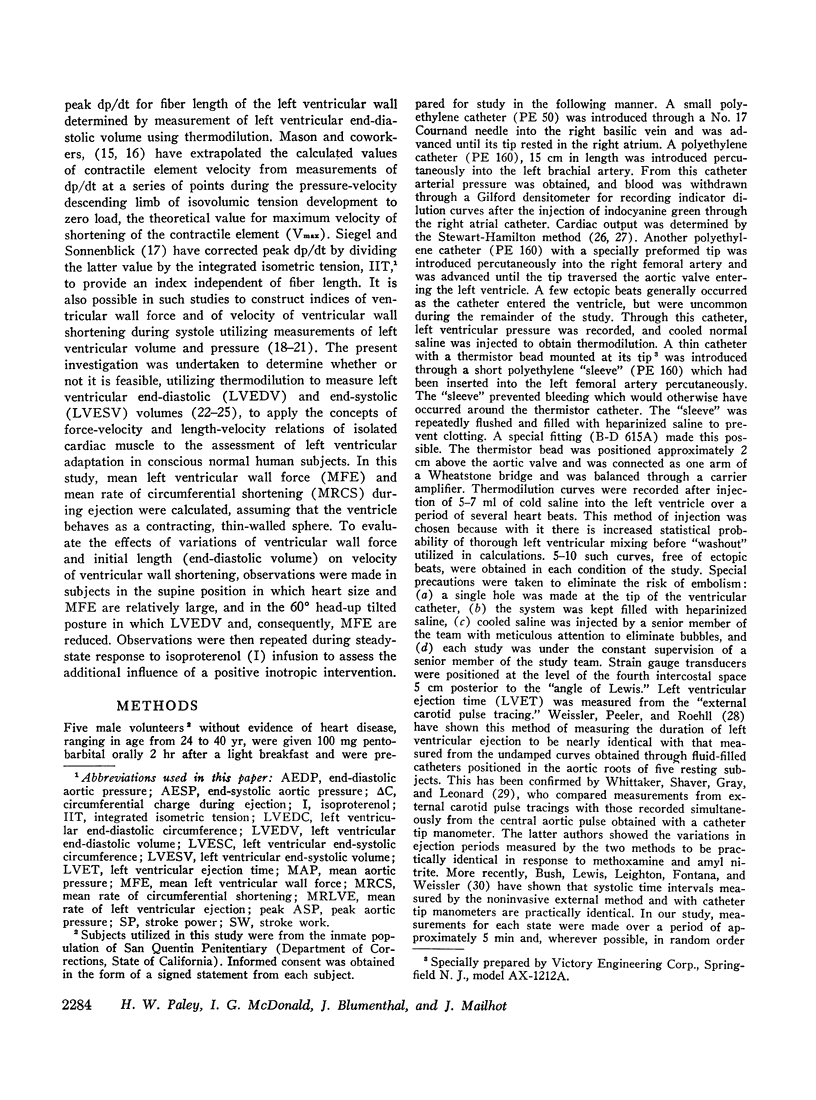
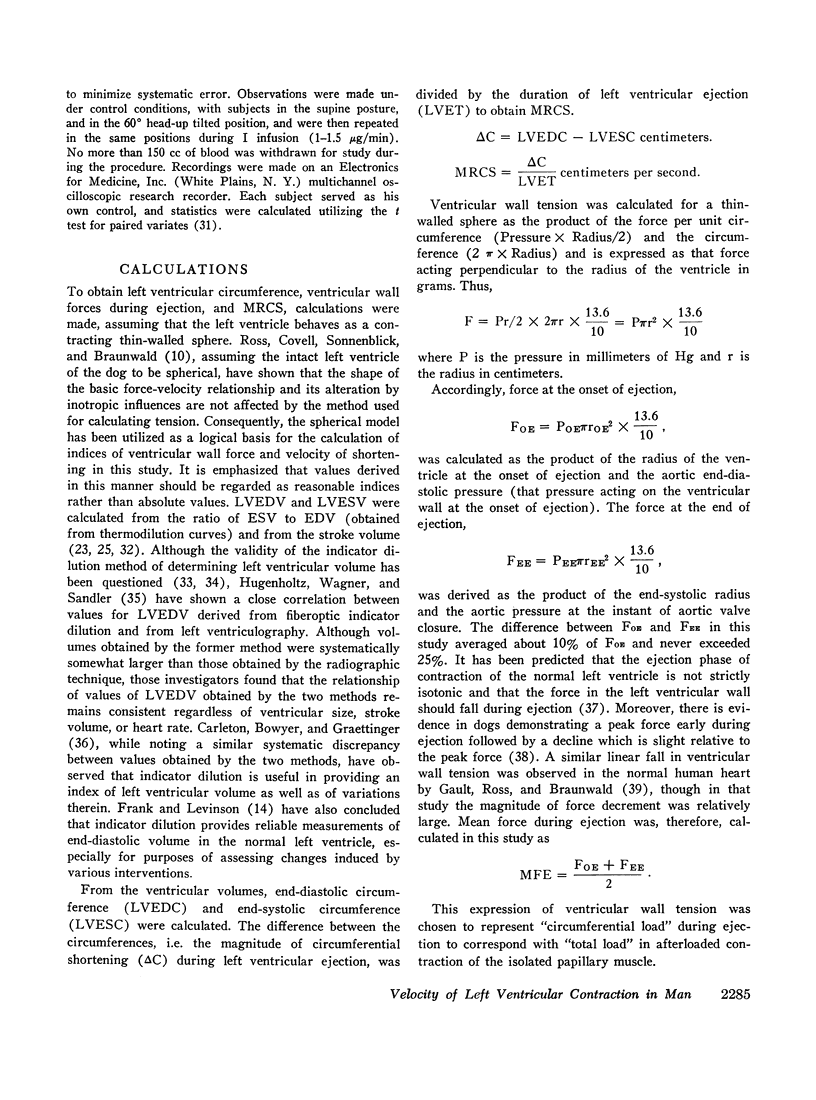
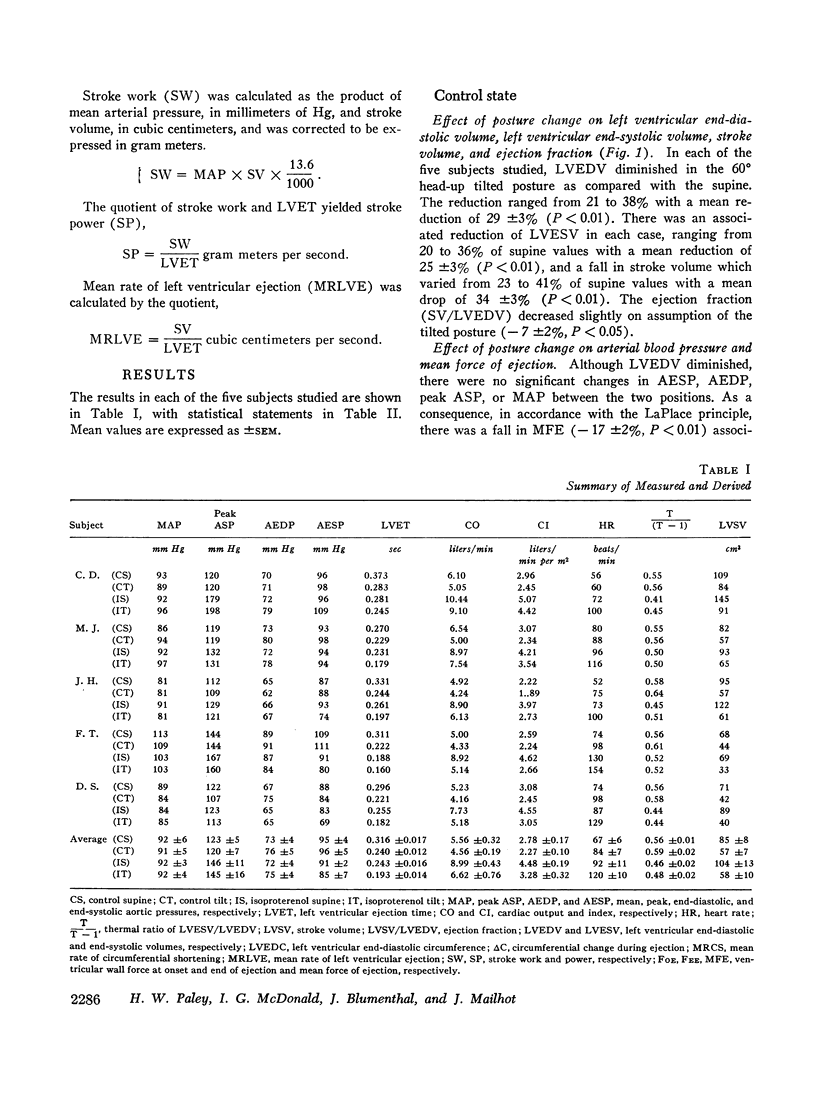
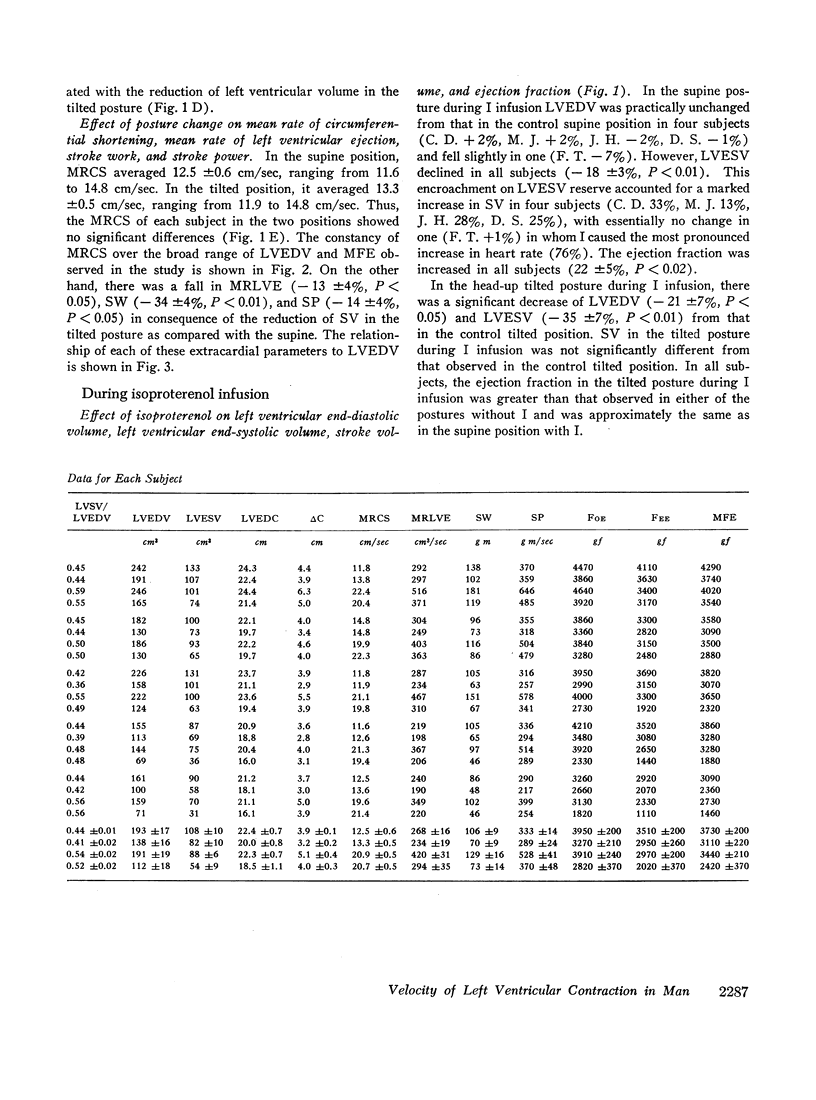
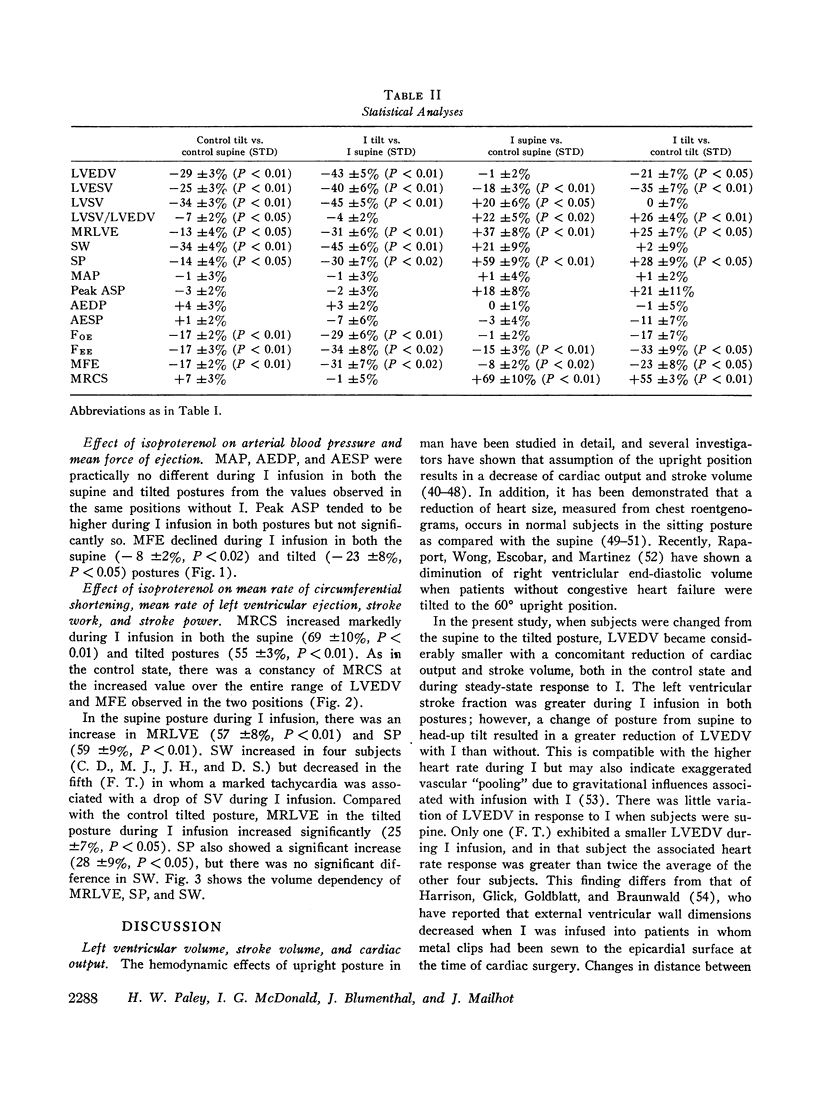
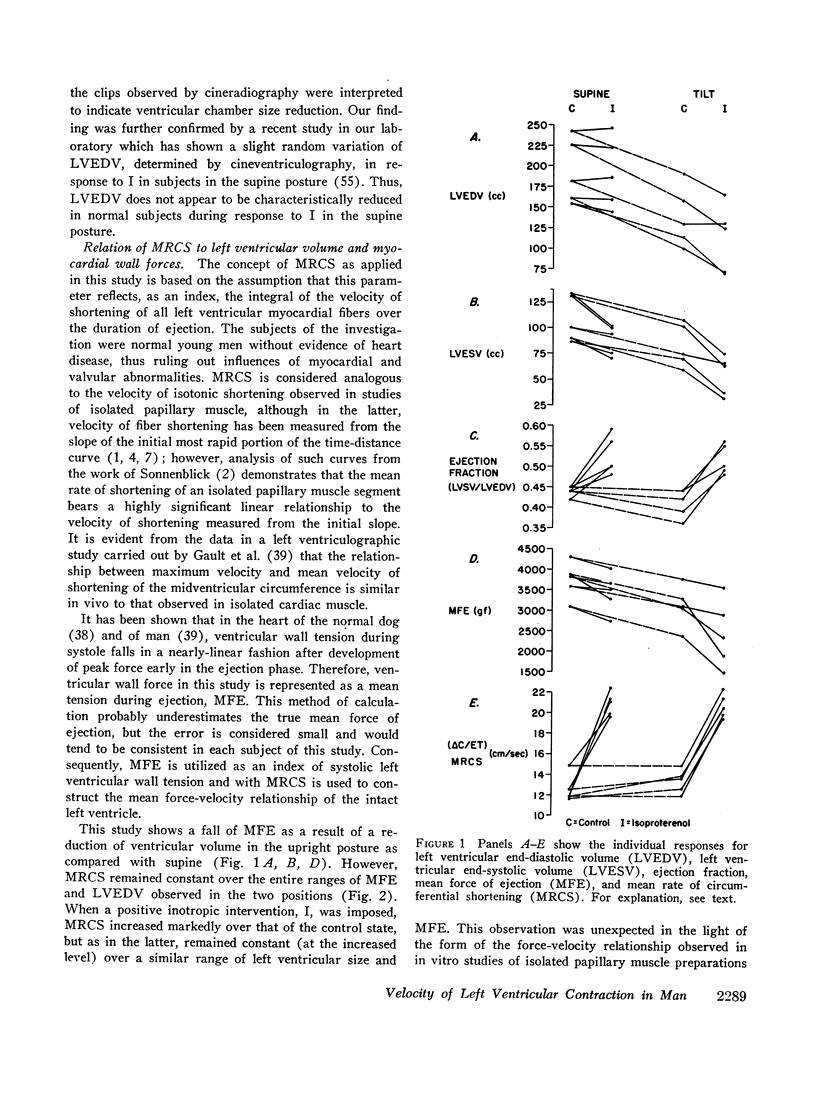
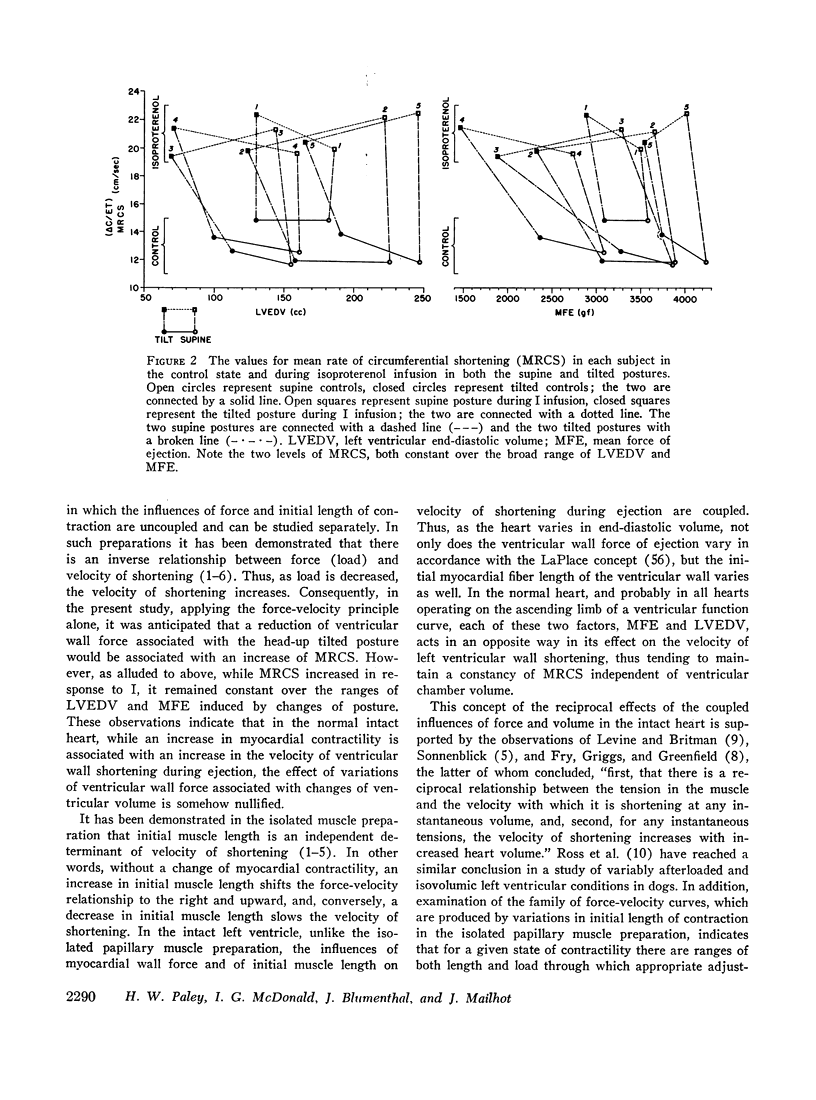
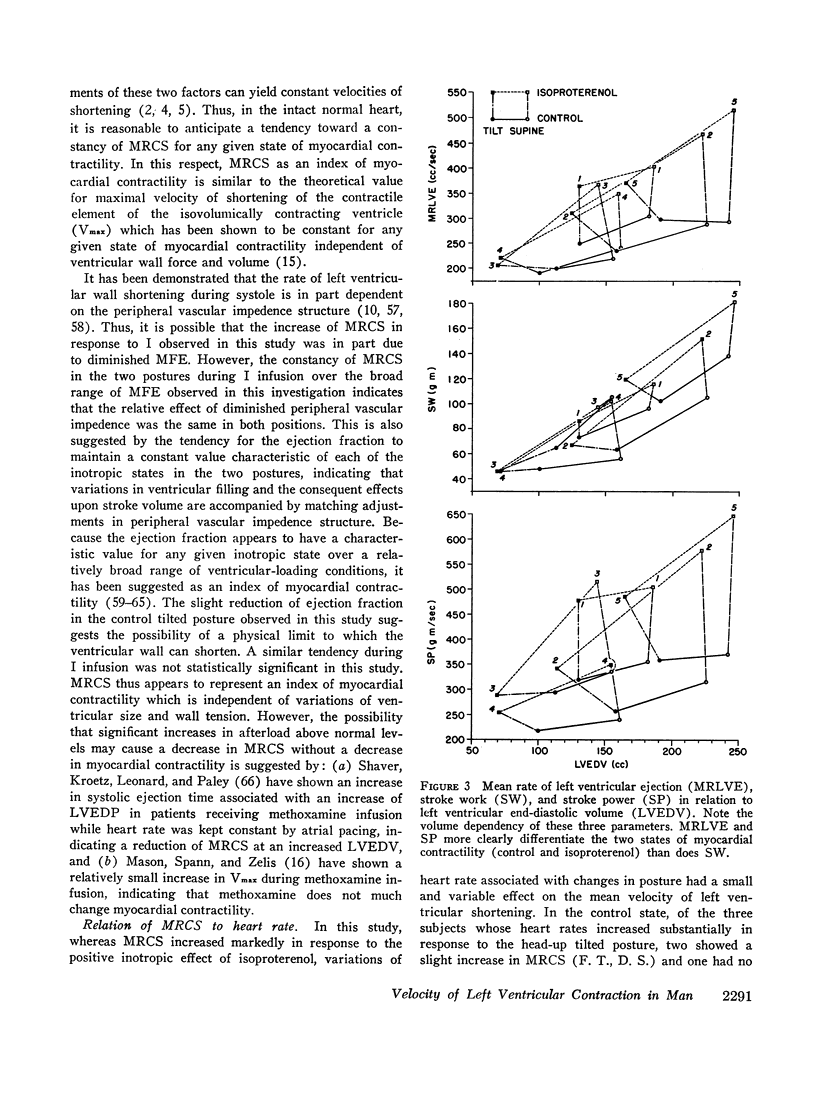
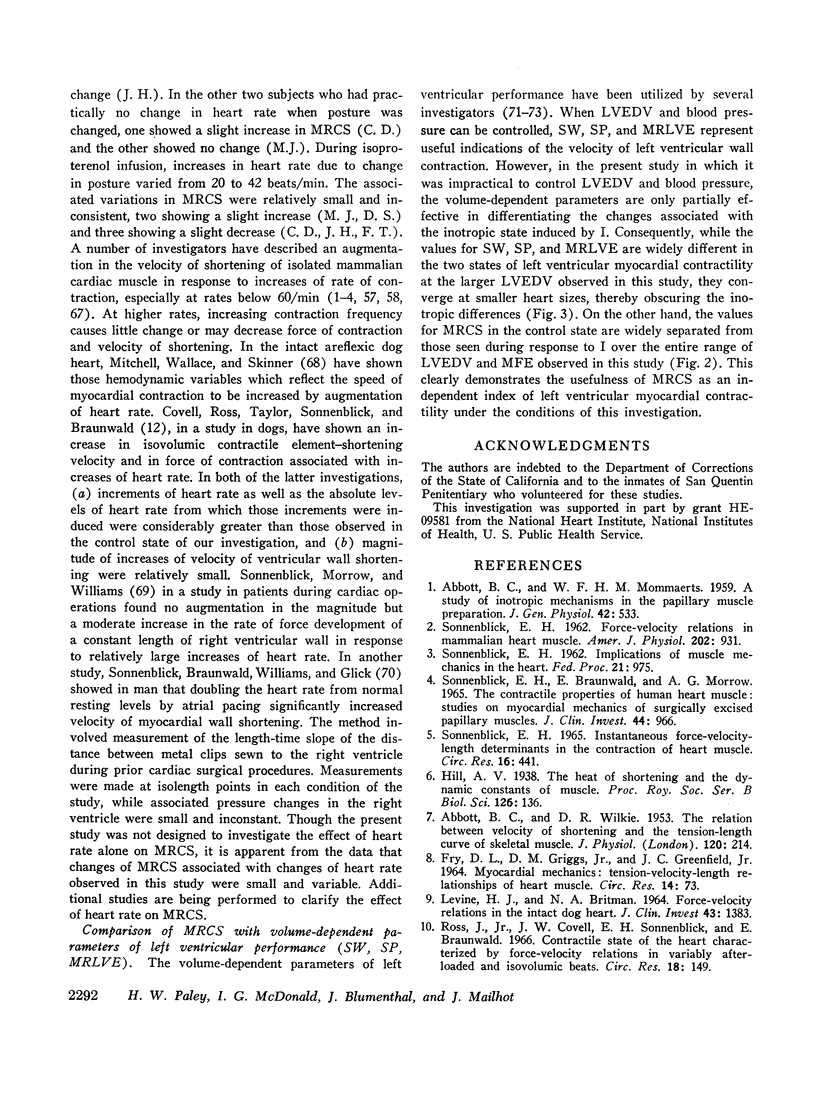
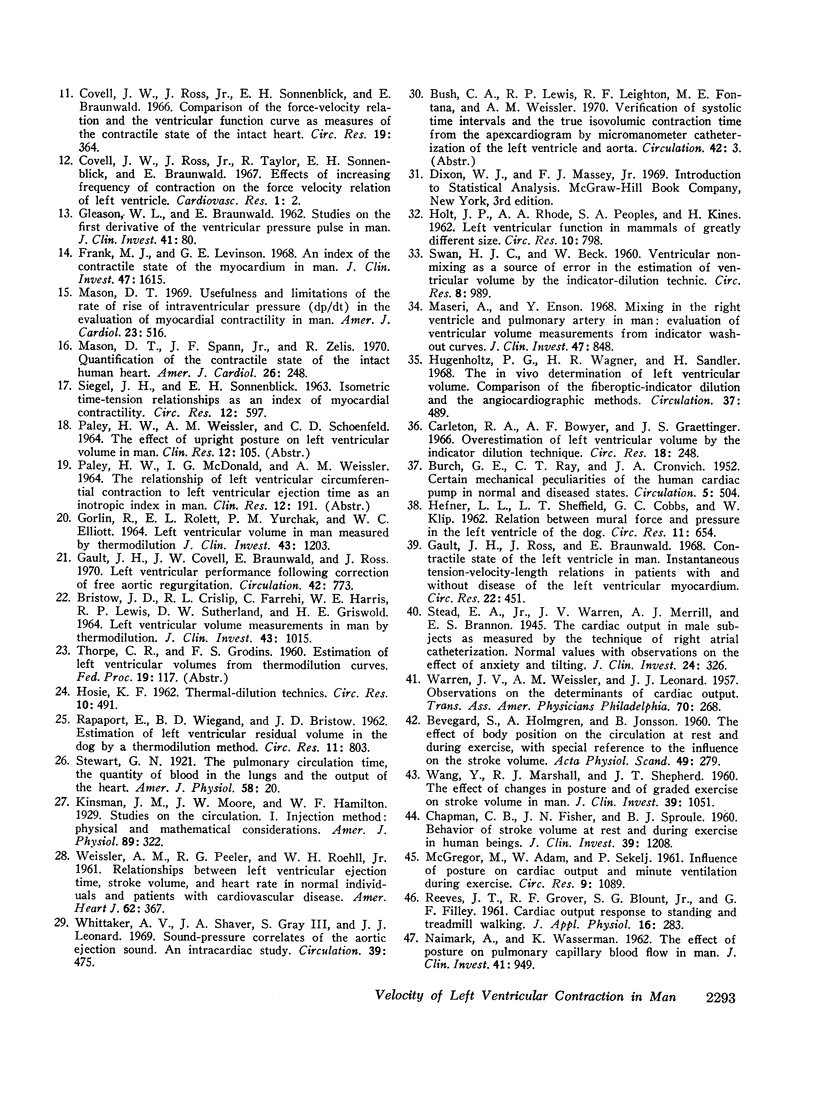
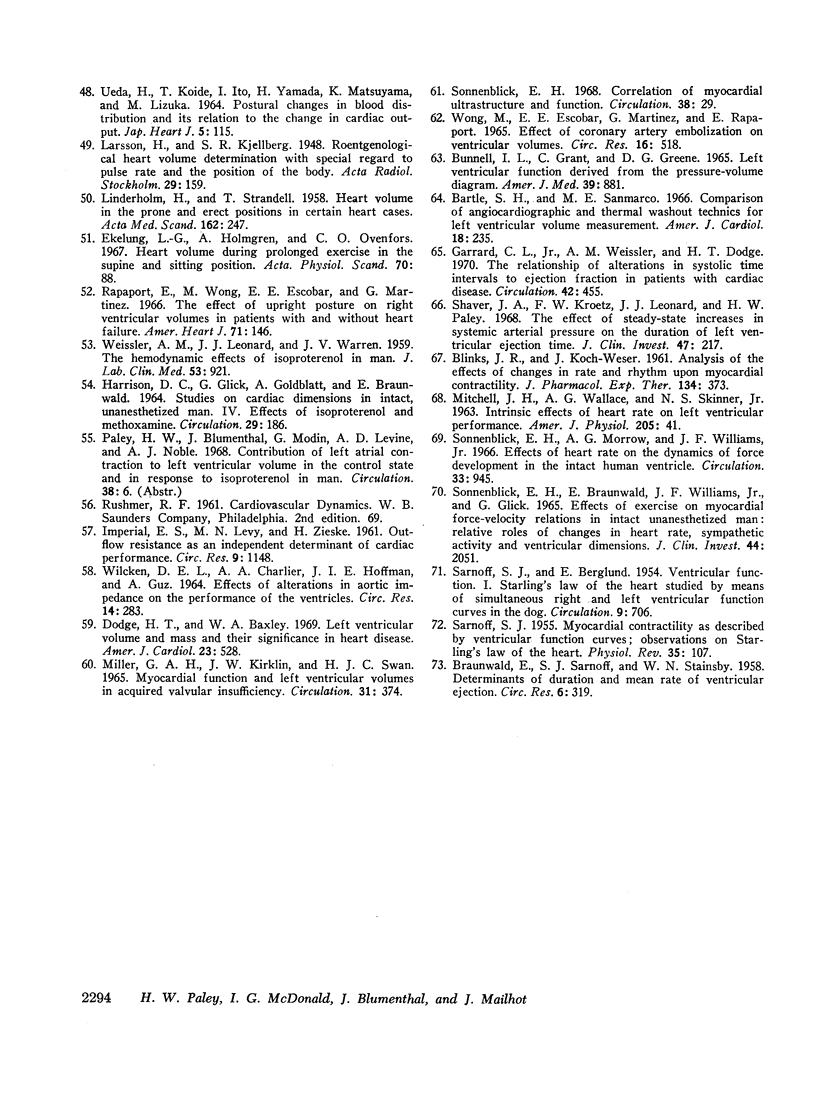
Selected References
These references are in PubMed. This may not be the complete list of references from this article.
- ABBOTT B. C., MOMMAERTS W. F. A study of inotropic mechanisms in the papillary muscle preparation. J Gen Physiol. 1959 Jan 20;42(3):533–551. doi: 10.1085/jgp.42.3.533. [DOI] [PMC free article] [PubMed] [Google Scholar]
- ABBOTT B. C., WILKIE D. R. The relation between velocity of shortening and the tension-length curve of skeletal muscle. J Physiol. 1953 Apr 28;120(1-2):214–223. doi: 10.1113/jphysiol.1953.sp004886. [DOI] [PMC free article] [PubMed] [Google Scholar]
- BEVEGARD S., HOLMGREN A., JONSSON B. The effect of body position on the circulation at rest and during exercise, with special reference to the influence on the stroke volume. Acta Physiol Scand. 1960 Jul 15;49:279–298. doi: 10.1111/j.1748-1716.1960.tb01953.x. [DOI] [PubMed] [Google Scholar]
- BLINKS J. R., KOCH-WESER J. Analysis of the effects of changes in rate and rhythm upon myocardial contractility. J Pharmacol Exp Ther. 1961 Dec;134:373–389. [PubMed] [Google Scholar]
- BRAUNWALD E., SARNOFF S. J., STAINSBY W. N. Determinants of duration and mean rate of ventricular ejection. Circ Res. 1958 May;6(3):319–325. doi: 10.1161/01.res.6.3.319. [DOI] [PubMed] [Google Scholar]
- BRISTOW J. D., CRISLIP R. L., FARREHI C., HARRIS W. E., LEWIS R. P., SUTHERLAND D. W., GRISWOLD H. E. LEFT VENTRICULAR VOLUME MEASUREMENTS IN MAN BY THERMODILUTION. J Clin Invest. 1964 Jun;43:1015–1024. doi: 10.1172/JCI104985. [DOI] [PMC free article] [PubMed] [Google Scholar]
- BURCH G. E., RAY C. T., CRONVICH J. A. Certain mechanical peculiarities of the human cardiac pump in normal and diseased states. Circulation. 1952 Apr;5(4):504–513. doi: 10.1161/01.cir.5.4.504. [DOI] [PubMed] [Google Scholar]
- Ballard K., McGregor F., Baxter H. An evaluation of the Parema four-layer bandage system. Br J Nurs. 2000 Sep 14;9(16):1089–1094. doi: 10.12968/bjon.2000.9.16.5481. [DOI] [PubMed] [Google Scholar]
- Bartle S. H., Sanmarco M. E. Comparison of angiocardiographic and thermal washout technics for left ventricular volume measurement. Am J Cardiol. 1966 Aug;18(2):235–252. doi: 10.1016/0002-9149(66)90036-1. [DOI] [PubMed] [Google Scholar]
- Bunnell I. L., Grant C., Greene D. G. Left ventricular function derived from the pressure-volume diagram. Am J Med. 1965 Dec;39(6):881–894. doi: 10.1016/0002-9343(65)90110-5. [DOI] [PubMed] [Google Scholar]
- CHAPMAN C. B., FISHER J. N., SPROULE B. J. Behavior of stroke volume at rest and during exercise in human beings. J Clin Invest. 1960 Aug;39:1208–1213. doi: 10.1172/JCI104136. [DOI] [PMC free article] [PubMed] [Google Scholar]
- Carleton R. A., Bowyer A. F., Graettinger J. S. Overestimation of left ventricular volume by the indicator dilution technique. Circ Res. 1966 Mar;18(3):248–256. doi: 10.1161/01.res.18.3.248. [DOI] [PubMed] [Google Scholar]
- Covell J. W., Ross J., Jr, Sonnenblick E. H., Braunwald E. Comparison of the force-velocity relation and the ventricular function curve as measures of the contractile state of the intact heart. Circ Res. 1966 Aug;19(2):364–372. doi: 10.1161/01.res.19.2.364. [DOI] [PubMed] [Google Scholar]
- Covell J. W., Ross J., Jr, Taylor R., Sonnenblick E. H., Braunwald E. Effects of increasing frequency of contraction on the force velocity relation of left ventricle. Cardiovasc Res. 1967 Jan;1(1):2–8. doi: 10.1093/cvr/1.1.2. [DOI] [PubMed] [Google Scholar]
- Dodge H. T., Baxley W. A. Left ventricular volume and mass and their significance in heart disease. Am J Cardiol. 1969 Apr;23(4):528–537. doi: 10.1016/0002-9149(69)90006-x. [DOI] [PubMed] [Google Scholar]
- Ekelund L. G., Holmgren A., Ovenfors C. O. Heart volume during prolonged exercise in the supine and sitting position. Acta Physiol Scand. 1967 May;70(1):88–98. doi: 10.1111/j.1748-1716.1967.tb03603.x. [DOI] [PubMed] [Google Scholar]
- FRY D. L., GRIGGS D. M., Jr, GREENFIELD J. C., Jr MYOCARDIAL MECHANICS: TENSION-VELOCITY-LENGTH RELATIONSHIPS OF HEART MUSCLE. Circ Res. 1964 Jan;14:73–85. doi: 10.1161/01.res.14.1.73. [DOI] [PubMed] [Google Scholar]
- Frank M. J., Levinson G. E. An index of the contractile state of the myocardium in man. J Clin Invest. 1968 Jul;47(7):1615–1626. doi: 10.1172/JCI105853. [DOI] [PMC free article] [PubMed] [Google Scholar]
- GLEASON W. L., BRAUNWALD E. Studies on the first derivative of the ventricular pressure pulse in man. J Clin Invest. 1962 Jan;41:80–91. doi: 10.1172/JCI104469. [DOI] [PMC free article] [PubMed] [Google Scholar]
- GORLIN R., ROLETT E. L., YURCHAK P. M., ELLIOTT W. C. LEFT VENTRICULAR VOLUME IN MAN MEASURED BY THERMODILUTION. J Clin Invest. 1964 Jun;43:1203–1221. doi: 10.1172/JCI105004. [DOI] [PMC free article] [PubMed] [Google Scholar]
- Garrard C. L., Jr, Weissler A. M., Dodge H. T. The relationship of alterations in systolic time intervals to ejection fraction in patients with cardiac disease. Circulation. 1970 Sep;42(3):455–462. doi: 10.1161/01.cir.42.3.455. [DOI] [PubMed] [Google Scholar]
- Gault J. H., Covell J. W., Braunwald E., Ross J., Jr Left ventricular performance following correction of free aortic regurgitation. Circulation. 1970 Nov;42(5):773–780. doi: 10.1161/01.cir.42.5.773. [DOI] [PubMed] [Google Scholar]
- Gault J. H., Ross J., Jr, Braunwald E. Contractile state of the left ventricle in man: instantaneous tension-velocity-length relations in patients with and without disease of the left ventricular myocardium. Circ Res. 1968 Apr;22(4):451–463. doi: 10.1161/01.res.22.4.451. [DOI] [PubMed] [Google Scholar]
- HARRISON D. C., GLICK G., GOLDBLATT A., BRAUNWALD E. STUDIES ON CARDIAC DIMENSIONS IN INTACT, UNANESTHETIZED MAN. IV. EFFECTS OF ISOPROTERENOL AND METHOXAMINE. Circulation. 1964 Feb;29:186–194. doi: 10.1161/01.cir.29.2.186. [DOI] [PubMed] [Google Scholar]
- HEFNER L. L., SHEFFIELD L. T., COBBS G. C., KLIP W. Relation between mural force and pressure in the left ventricle of the dog. Circ Res. 1962 Oct;11:654–663. doi: 10.1161/01.res.11.4.654. [DOI] [PubMed] [Google Scholar]
- HOLT J. P., RHODE E. A., PEOPLES S. A., KINES H. Left ventricular function in mammals of greatly different size. Circ Res. 1962 May;10:798–806. doi: 10.1161/01.res.10.5.798. [DOI] [PubMed] [Google Scholar]
- HOSIE K. F. Thermal-dilution technics. Circ Res. 1962 Mar;10:491–504. doi: 10.1161/01.res.10.3.491. [DOI] [PubMed] [Google Scholar]
- Hugenholtz P. G., Wagner H. R., Sandler H. The in vivo determination of left ventricular volume. Comparison of the fiberoptic-indicator dilution and the angiocardiographic methods. Circulation. 1968 Apr;37(4):489–508. doi: 10.1161/01.cir.37.4.489. [DOI] [PubMed] [Google Scholar]
- LEVINE H. J., BRITMAN N. A. FORCE-VELOCITY RELATIONS IN THE INTACT DOG HEART. J Clin Invest. 1964 Jul;43:1383–1396. doi: 10.1172/JCI105014. [DOI] [PMC free article] [PubMed] [Google Scholar]
- LINDERHOLM H., STRANDELL T. Heart volume in the prone and erect positions in certain heart cases. Acta Med Scand. 1958 Nov 10;162(4):247–261. doi: 10.1111/j.0954-6820.1958.tb01772.x. [DOI] [PubMed] [Google Scholar]
- MILLER G. A., KIRKLIN J. W., SWAN H. J. MYOCARDIAL FUNCTION AND LEFT VENTRICULAR VOLUMES IN ACQUIRED VALVULAR INSUFFICIENCY. Circulation. 1965 Mar;31:374–384. doi: 10.1161/01.cir.31.3.374. [DOI] [PubMed] [Google Scholar]
- Maseri A., Enson Y. Mixing in the right ventricle and pulmonary artery in man: evaluation of ventricular volume measurements from indicator washout curves. J Clin Invest. 1968 Apr;47(4):848–859. doi: 10.1172/JCI105778. [DOI] [PMC free article] [PubMed] [Google Scholar]
- Mason D. T., Spann J. F., Jr, Zelis R. Quantification of the contractile state of the intact human heart. Maximal velocity of contractile element shortening determined by the instantaneous relation between the rate of pressure rise and pressure in the left ventricle during isovolumic systole. Am J Cardiol. 1970 Sep;26(3):248–257. doi: 10.1016/0002-9149(70)90791-5. [DOI] [PubMed] [Google Scholar]
- Mason D. T. Usefulness and limitations of the rate of rise of intraventricular pressure (dp-dt) in the evaluation of myocardial contractility in man. Am J Cardiol. 1969 Apr;23(4):516–527. doi: 10.1016/0002-9149(69)90005-8. [DOI] [PubMed] [Google Scholar]
- NAIMARK A., WASSERMAN K. The effect of posture on pulmonary capillary blood flow in man. J Clin Invest. 1962 May;41:949–954. doi: 10.1172/JCI104573. [DOI] [PMC free article] [PubMed] [Google Scholar]
- RAPAPORT E., WIEGAND B. D., BRISTOW J. D. Estimation of left ventricular residual volume in the dog by a thermodilution method. Circ Res. 1962 Nov;11:803–810. doi: 10.1161/01.res.11.5.803. [DOI] [PubMed] [Google Scholar]
- REEVES J. T., GROVER R. F., BLOUNT S. G., Jr, FILLEY G. F. Cardiac output response to standing and treadmill walking. J Appl Physiol. 1961 Mar;16:283–288. doi: 10.1152/jappl.1961.16.2.283. [DOI] [PubMed] [Google Scholar]
- Rapaport E., Wong M., Escobar E. E., Martinez G. The effect of upright posture on right ventricular volumes in patients with and without heart failure. Am Heart J. 1966 Feb;71(2):146–152. doi: 10.1016/0002-8703(66)90177-3. [DOI] [PubMed] [Google Scholar]
- SARNOFF S. J., BERGLUND E. Ventricular function. I. Starling's law of the heart studied by means of simultaneous right and left ventricular function curves in the dog. Circulation. 1954 May;9(5):706–718. doi: 10.1161/01.cir.9.5.706. [DOI] [PubMed] [Google Scholar]
- SARNOFF S. J. Myocardial contractility as described by ventricular function curves; observations on Starling's law of the heart. Physiol Rev. 1955 Jan;35(1):107–122. doi: 10.1152/physrev.1955.35.1.107. [DOI] [PubMed] [Google Scholar]
- SIEGEL J. H., SONNENBLICK E. H. Isometric time-tension relationships as an index of myocardial contractility. Circ Res. 1963 Jun;12:597–610. doi: 10.1161/01.res.12.6.597. [DOI] [PubMed] [Google Scholar]
- SONNENBLICK E. H., BRAUNWALD E., MORROW A. G. THE CONTRACTILE PROPERTIES OF HUMAN HEART MUSCLE: STUDIES ON MYOCARDIAL MECHANICS OF SURGICALLY EXCISED PAPILLARY MUSCLES. J Clin Invest. 1965 Jun;44:966–977. doi: 10.1172/JCI105214. [DOI] [PMC free article] [PubMed] [Google Scholar]
- SONNENBLICK E. H. Force-velocity relations in mammalian heart muscle. Am J Physiol. 1962 May;202:931–939. doi: 10.1152/ajplegacy.1962.202.5.931. [DOI] [PubMed] [Google Scholar]
- SONNENBLICK E. H. INSTANTANEOUS FORCE-VELOCITY-LENGTH DETERMINANTS IN THE CONTRACTION OF HEART MUSCLE. Circ Res. 1965 May;16:441–451. doi: 10.1161/01.res.16.5.441. [DOI] [PubMed] [Google Scholar]
- SONNENBLICK E. H. Implications of muscle mechanics in the heart. Fed Proc. 1962 Nov-Dec;21:975–990. [PubMed] [Google Scholar]
- SWAN H. J., BECK W. Ventricular nonmixing as a source of error in the estimation of ventricular volume by the indicator-dilution technic. Circ Res. 1960 Sep;8:989–998. doi: 10.1161/01.res.8.5.989. [DOI] [PubMed] [Google Scholar]
- Shaver J. A., Kroetz F. W., Leonard J. J., Paley H. W. The effect of steady-state increases in systemic arterial pressure on the duration of left ventricular ejection time. J Clin Invest. 1968 Jan;47(1):217–230. doi: 10.1172/JCI105711. [DOI] [PMC free article] [PubMed] [Google Scholar]
- Sonnenblick E. H., Braunwald E., Williams J. F., Jr, Glick G. Effects of exercise on myocardial force-velocity relations in intact unanesthetized man: relative roles of changes in heart rate, sympathetic activity, and ventricular dimensions. J Clin Invest. 1965 Dec;44(12):2051–2062. doi: 10.1172/JCI105312. [DOI] [PMC free article] [PubMed] [Google Scholar]
- Sonnenblick E. H. Correlation of myocardial ultrastructure and function. Circulation. 1968 Jul;38(1):29–44. doi: 10.1161/01.cir.38.1.29. [DOI] [PubMed] [Google Scholar]
- Sonnenblick E. H., Morrow A. G., Williams J. F., Jr Effects of heart rate on the dynamics of force development in the intact human ventricle. Circulation. 1966 Jun;33(6):945–951. doi: 10.1161/01.cir.33.6.945. [DOI] [PubMed] [Google Scholar]
- Stead E. A., Warren J. V., Merrill A. J., Brannon E. S. THE CARDIAC OUTPUT IN MALE SUBJECTS AS MEASURED BY THE TECHNIQUE OF RIGHT ATRIAL CATHETERIZATION. NORMAL VALUES WITH OBSERVATIONS ON THE EFFECT OF ANXIETY AND TILTING. J Clin Invest. 1945 May;24(3):326–331. doi: 10.1172/JCI101609. [DOI] [PMC free article] [PubMed] [Google Scholar]
- UEDA H., KOIDE T., ITO I., YAMADA H., MATSUYAMA K., IIZUKA M. POSTURAL CHANGES IN BLOOD DISTRIBUTION AND ITS RELATION TO THE CHANGE IN CARDIAC OUTPUT. Jpn Heart J. 1964 Mar;5:115–126. doi: 10.1536/ihj.5.115. [DOI] [PubMed] [Google Scholar]
- WANG Y., MARSHALL R. J., SHEPHERD J. T. The effect of changes in posture and of graded exercise on stroke volume in man. J Clin Invest. 1960 Jul;39:1051–1061. doi: 10.1172/JCI104120. [DOI] [PMC free article] [PubMed] [Google Scholar]
- WARREN J. V., WEISSLER A. M., LEONARD J. J. Observations on the determinants of cardiac output. Trans Assoc Am Physicians. 1957;70:268–274. [PubMed] [Google Scholar]
- WEISSLER A. M., LEONARD J. J., WARREN J. V. The hemodynamic effects of isoproterenol in man, with observations on the role of the central blood volume. J Lab Clin Med. 1959 Jun;53(6):921–925. [PubMed] [Google Scholar]
- WEISSLER A. M., PEELER R. G., ROEHLL W. H., Jr Relationships between left ventricular ejection time, stroke volume, and heart rate in normal individuals and patients with cardiovascular disease. Am Heart J. 1961 Sep;62:367–378. doi: 10.1016/0002-8703(61)90403-3. [DOI] [PubMed] [Google Scholar]
- WILCKEN D. E., CHARLIER A. A., HOFFMAN J. I., GUZ A. EFFECTS OF ALTERATIONS IN AORTIC IMPEDANCE ON THE PERFORMANCE OF THE VENTRICLES. Circ Res. 1964 Apr;14:283–293. doi: 10.1161/01.res.14.4.283. [DOI] [PubMed] [Google Scholar]
- WONG M., ESCOBAR E. E., MARTINEZ G., RAPAPORT E. EFFECT OF CORONARY ARTERY EMBOLIZATION ON VENTRICULAR VOLUMES. Circ Res. 1965 Jun;16:518–526. doi: 10.1161/01.res.16.6.518. [DOI] [PubMed] [Google Scholar]
- Whittaker A. V., Shaver J. A., Gray S., 3rd, Leonard J. J. Sound-pressure correlates of the aortic ejection sound. An intracardiac sound study. Circulation. 1969 Apr;39(4):475–486. doi: 10.1161/01.cir.39.4.475. [DOI] [PubMed] [Google Scholar]


